The lab test kit enables you to provide a small blood sample, collected from a finger prick, to be tested at our lab.
Some samples will be tested for both HIV and syphilis, and others for HIV only. Check the lab card that comes with your kit to see which tests we can run on your sample.
You don’t need to write your name on your sample. The kit will arrive pre-labelled with a unique code. This is to ensure your testing experience is as easy and discreet as possible.
We have recently updated the design of our kits to use less plastic. If you received our previous kit, with a protective case and plastic return envelope, please follow the instructions on the card that came with it.
Order a home test kitThe most accurate way to test for HIV and syphilis is to do a blood test.
Our lab test kits enable you to safely take a blood sample at home. You will not get results immediately. You will need to freepost return your sample to our lab for testing.
It is best to do this when you have 5-10 minutes to spare. Being warm and hydrated and keeping your arm straight will help blood flow to your finger. Try taking a shower or bath, soaking your hands in warm water, exercising or holding a warm mug.
Read through all of the steps before you start.
Remove the yellow lid from the tube.
Place the tube on a flat surface so it can stand up.
Twist and pull the tip off a lancet. Then use a wipe to sterilise your chosen finger.
If you feel faint, ask someone to help or be with you. Stand up but have a chair nearby.
To make the small cut, lay your hand on a flat surface and press the lancet firmly into the side of your fingertip where the skin is softer.
If the lancet doesn’t work, try another.
Stand up over the tube, keeping your arm straight. Massage down from your palm to your fingertip, directing drops of blood into the tube. If your blood stops flowing, before pricking another finger, try to warm up, exercise and rehydrate.
Once you have filled to the 600 line, push the yellow lid down so it clicks. If you can’t get to 600 but are over 400, send your sample back anyway.
Use a sterile wipe to clean your finger then apply a plaster. Use a tissue to wipe the sample tube clean. Turn the tube upside down 5 times.
Place the sample tube inside the specimen transport bag. Peel off the yellow strip, fold and seal the bag. Place the sealed bag and your lab card into the Freepost box addressed to our lab.
Close the box using the security seal sticker. Note down your tracking ID which starts with a # and is found under the barcode on the address label of the lab return box. Post your sample in any Royal Mail post box.
Many people find it easier and quicker to complete the sample after watching this short video.
We will send you a text when your sample arrives at the lab.
If there is not enough blood or if the sample gets lost or damaged in the post, one of our clinicians can offer you another kit to repeat the test.
The lab will run a test on your sample. This will give a negative or a reactive result. We should be able to give you your results within three working days of it arriving at the lab.
If you have a negative result we will notify you by text. If you are worried about privacy, you may want to amend the notification settings on your phone, so that text messages are not displayed on your home screen when your phone is locked.
No test is 100% accurate but the tests that we use are very sensitive. So if you have a negative result, and you have tested 7 weeks after potential exposure to HIV, and 12 weeks after potential exposure to syphilis, then you can be confident that you don’t have these infections. Find out more about when to test.
If you have a reactive result we will call to offer you support and help you arrange further confirmatory testing at a clinic near you. Some people can be very worried if they receive a reactive result, so we are here to answer any questions and explain what this result means.
A reactive result means that the test has reacted with something in your blood that could be (but is not necessarily) the HIV virus or antibodies to the HIV virus. A reactive result is not the same as a positive result.
When you go to a clinic for further testing, they will take another blood sample so they can run the full set of tests. These tests will give you a definitive result: negative or positive for HIV.
If these tests show you have a positive HIV result, the clinic will also be able to see what stage of HIV infection you have and refer you immediately to a specialist clinic to talk about treatment options.
The World Health Organisation guidance on HIV testing says that an HIV diagnosis can only be confirmed after completing 3 separate tests. Your home test kit sample provides enough blood to do the first of these tests.
Find out more about what a reactive result means and how common they are.
There are two types of syphilis test. The test we run on your blood sample can only be offered to people who have not had treatment for syphilis in the past. If you have received treatment in the past, the TPPA (Treponema pallidum particle agglutination assay) test we do is likely to show a reactive result, as it can detect past infections.
A reactive syphilis result requires confirmatory testing in a sexual health clinic. A second type of test, such as a RPR (rapid plasma reagin) will check whether the antibodies detected are from a new infection or a previous one. If your confirmatory test returns a positive syphilis result, the clinic can also tell you what stage of syphilis you have and refer you immediately to a specialist clinic to discuss treatment options.
If you have questions or want some further support or advice, reply to one of our text messages. Our clinical team will read and respond to your message.
The kit components may expire after 6 months. We ask you to write the date you completed the test kit on your lab card so that we know your sample was taken recently, even if your kit has been ordered some months ago.
We ask that you only order a kit if you plan to use it soon, otherwise you are keeping hold of a kit that someone else could be making use of. Funding for the service is limited, so we want to reduce waste wherever possible.
Your blood sample will be viable for laboratory testing for up to 7 days, so we advise posting it as soon as you can after taking the test. There is less risk of your blood drying out or clotting if you post it right away.
Tipping your blood sample tube upside down a few times before laying it in its protective packaging will also help prevent blood clotting. The gel at the bottom of the tube is designed to protect your blood sample from haemolysing (breaking down).
When you take your test, please:
If there is not enough blood or the sample gets lost or damaged in the post, one of our clinicians can offer you another kit to repeat the test.
No. This lab test kit allows you to take a small sample and return it to our laboratory for testing. Once the lab has received your sample, you should get your results within three working days, though results often come sooner.
This is not a rapid self-test for HIV, where the testing device shosw you a reactive or negative result. Instead, your sample will be tested by our professional laboratory. Our clinicians will be there to support you if you have a reactive result.
No. Your test kit will arrive in a grey envelope with your address label, a franked postage label and a sticker with a barcode that we use to track the dispatch of your kit. There is nothing on the package to suggest it contains a test kit or has anything to do with your health.
Some people experience pain or discomfort, whilst many other people don’t. We have heard that people who prick the centre of their finger can find this area more sensitive afterwards, so we recommend using the lancets on the side or outside edge of your finger.
Some people who have a fear or phobia of needles are reassured by knowing the lancet is not a needle but a very small flat blade that makes a small cut. It is enclosed in order to keep it sterile and safe.
The best thing you can do is try to get warmed up just before using the lancet to prick your finger. To help your blood flow:
If you are still struggling, make sure when taking the test you:
If you want support or advice from our clinical team, or if you have used all 3 lancets and need more, you can reply to one of our text messages.
Your local council will decide whether or not to commission us to offer you HIV or HIV and syphilis testing. In previous years, the National HIV Prevention Programme has not provided syphilis testing. This was a new addition when Freetesting.hiv was launched in October 2019.
We can only offer syphilis testing if you have not received treatment for syphilis in the past. Our test is so sensitive that it could pick up antibodies from previous infections.
During the order process, we will recommend you have a syphilis test at your local sexual health clinic instead.
It is possible to test your blood sample for both HIV and syphilis. You will not have to provide an extra sample to get two results.
If you would like syphilis tests available on Freetesting.hiv in your area, please email to let us know: sh24.info@nhs.net.
Otherwise, check if you are eligible for a full STI home testing kit from SH:24, or find your local clinic.
Our HIV test may use either 4th or 5th Generation Assay. This tests for HIV I and II/p24 antigen.
Our Syphilis test is an ECLIA (ElectroChemiLuminescence ImmunoAssay). This test looks for antibodies known as immunoglobulin IgG and IgM.
Our laboratory screens for both HIV and syphilis using the Roche Cobas E Modular platform or the BioRad Bio-plex system.
Finding out that you have an HIV infection and starting treatment early means you:
The rapid self-test kit enables you to test a single drop of blood from a finger prick for instant results, at home, with no need to post anything.
Read the instructions carefully. They tell you exactly how to do the test and read the result.
You only need 1 drop of blood from your fingertip to read your own result immediately at home.
It is best to do this when you have 5-10 minutes to spare. Being warm and keeping your arm straight will help blood flow to your finger.
The manufacturer's instructions come with the kit. Read them through before doing the test.
Put the rapid self-test device on a clean, flat surface and make sure you read the manufacturer's instructions carefully.

Use the lancet to make a tiny prick in your fingertip. You only need 1 drop of blood from your finger and this is easier if your hands are warm. The lancet only feels like a pinch.
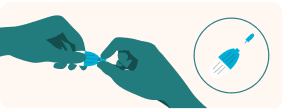
Let 1 drop of blood fall into the bottle. Twist on the cap. Shake the bottle 4 times and pour all the liquid into the test device. Wait until all the liquid has disappeared.

Follow the instructions to pour the liquid from these bottles into the test device. First, pour all the liquid from bottle 2 and wait until it all disappears. Then pour in the contents of bottle 3. You'll see your result in a few minutes.
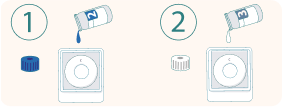
Do not wait long to check your result. If you leave the test to develop for over an hour, the result will not be valid.

You need a single drop of blood from your fingertip to take the rapid self-test. Watch this short video to see how to do the test at home.
Once you’ve read your result, you can report it online. This means we can offer you the right support. And it helps us to evaluate and improve our service.
No test is 100% accurate but the tests that we use are very sensitive. So if you have a negative result, and you have tested 12 weeks after potential exposure to HIV, then you can be confident that you don’t have an infection. Find out more about when to test.
If you report a reactive result we can help you arrange further testing at a clinic near you. You can call us, email us at freetesting.results@nhs.net or just reply to one of our text messages. Getting a reactive result can be worrying, so we’re here to answer any questions and explain what this result means.
A reactive result means that the test has reacted with something in your blood that could be (but is not necessarily) the HIV virus or antibodies to the HIV virus. A reactive result is not the same as a positive result.
When you go to a clinic for further testing, they will take a larger blood sample so they can run the full set of tests. These tests will give you a definitive result: negative or positive for HIV.
If these tests show you have a positive HIV result, the clinic will also be able to see what stage of HIV infection you have and refer you immediately to a specialist clinic to talk about treatment options.
The World Health Organisation guidance on HIV testing says that an HIV diagnosis can only be confirmed after completing 3 separate tests. Your home test kit sample provides enough blood to do the first of these tests.
Find out more about what a reactive result means and how common they are.
These images are a quick reference guide. Remember to read the full instructions inside the test kit before starting your test.
If you see 1 dot at the top (this can also be a faint dot) this is a negative result. You do not have the infection. If you think you have a high chance of getting HIV, you should test every 3 months. You might also want to look into PrEP, a medication that prevents HIV infection. Find out more about PrEP.
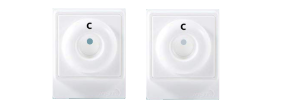
It is important to know that a reactive result is not a diganosis of HIV - this is not a positive result. When you report a reactive result, we will offer you support and help you to arrange a visit to a sexual health clinic near you for more detailed testing.
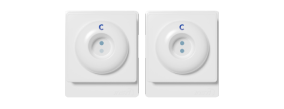
This means the test did not work. This happens sometimes. Text INVALID to 07860 064 295 and we can send you a new kit.
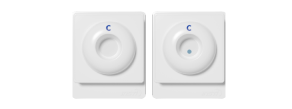
Your kit has an expiry date shown on the box. Do not use the test after this date.
We ask that you only order a kit if you plan to use it soon. We have limited funding for this service and want to reduce waste as much as we can.
No. Your test kit will arrive in a grey envelope with your address label, a franked postage label and a sticker with a barcode that we use to track the dispatch of your kit. There is nothing on the package to suggest it contains a test kit or has anything to do with your health.
Some people experience pain or discomfort, whilst many other people don’t. We have that heard if you prick the centre of your finger it can be more sensitive afterwards. So we recommend using the lancet on the side or outside edge of your finger.
Some people who have a fear or phobia of needles are reassured by knowing the lancet is not a needle. It’s a very small flat blade that makes a tiny cut. It’s enclosed in order to keep it sterile and safe.
The rapid self-test has a built-in control dot to show that the test has been performed correctly and that you have added the correct amount of blood. If the control dot does not appear, your test has not worked. Throw away this test and try again with a new kit.
If only the control dot is visible it means that your result is negative, and you probably do not have HIV. If 2 dots are visible your test result is reactive. If your result is reactive we'll ask you to go to a sexual health clinic so that you can get further tests.
After the test is complete, you can read your result instantly. No timers needed!
A reactive result means that the test has reacted with something in your blood. It could be a sign of HIV infection, but it’s not the same as a positive result.
We follow the World Health Organization's guidance on HIV testing. This says that HIV can only be diagnosed after completing 3 separate tests. These tests look for 3 different parts of the HIV virus or its antibodies.
If you have a reactive result on your first test then we'll ask you to go to a sexual health clinic so that they can complete the second and third tests. About a third of reactive results will be confirmed as positive in a clinic.
If you're worried about a reactive result or are anxious about waiting for another test, contact our clinicians. We can talk you through the process and answer your questions.
Telling us your result is important as it helps us to understand how our service is working and to offer you the right support.
Use the link we sent to you by text message to tell us your result. It only takes around 30 seconds. Alternatively, you can go to our result page and enter your mobile number and the test kit code we sent to you by text.
If you don’t have a link, you can contact us by text message, email or phone to tell us your result.
Finding out that you have an HIV infection and starting treatment early means you:
After exposure to HIV, it can take from 3 to 12 weeks (21-84 days) for an infected person’s body to make enough antibodies for a screening test to detect them. This is called the window period.
An individual may test positive with the rapid self-test in as little as 21-22 days after infection, however depending on the person it can take as long as 3 months for them to produce sufficient antibodies to generate a positive result.
A negative result may not be accurate until 3 months after a possible exposure. If someone has been exposed to HIV and obtains a negative test result during the window period, they should re-test 3 months after possible exposure to HIV.